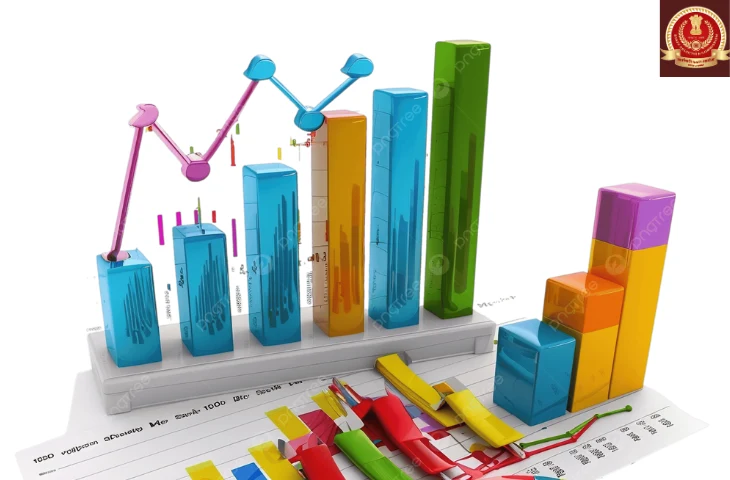In SSC CGL Tier 2 SSC JSO, Time Series Analysis is an important topic under Statistical Methods. It is used to analyze data collected over time to identify patterns, trends, and seasonal effects. This blog explains the concepts of trend determination and seasonal variation in a simple way with formulas and examples for quick revision.
What is Time Series Analysis?
A time series is a sequence of data points collected at regular intervals over time.
Examples include:
- Monthly sales of a company
- Daily temperature readings
- Annual population growth
Time series analysis helps in:
- Understanding past data
- Identifying patterns
- Forecasting future values
Also check out Most Repeated Quantitative Aptitude Questions for SSC CGL Tier 2
Components of a Time Series
A time series typically has four main components:
| Component | Description |
| Trend (T) | Long-term movement or general direction of data (upward, downward, or constant) |
| Seasonal (S) | Regular pattern repeating at fixed intervals (e.g., monthly, quarterly) |
| Cyclical (C) | Fluctuations due to economic or business cycles over several years |
| Irregular/Random (I) | Unpredictable variations due to random events or noise |
Also check out Most Repeated Quantitative Aptitude Questions for SSC CGL Tier 2
Trend Determination
Trend shows the long-term direction in a time series. It helps in understanding the overall movement of data over time, ignoring seasonal and random variations.
Methods to Determine Trend
- Graphical Method:
- Plot data on a graph and observe the general direction (upward, downward, or flat).
- Semi-Average Method:
- Divide data into two halves.
- Calculate the average for each half.
- Plot these averages and join them with a straight line to observe the trend.
- Moving Average Method:
- Calculate averages of consecutive data points (e.g., 3-month, 5-year).
- Smooths short-term fluctuations to highlight trend.
Example:
Monthly sales data: 100, 120, 130, 140, 150, 170
- 3-month moving average: (100+120+130)/3 = 116.67, (120+130+140)/3 = 130, …
Check out Most Repeated Reasoning Questions for SSC CGL Tier 2
Seasonal Variation
Seasonal variation is a pattern that repeats regularly over fixed periods, usually within a year.
- Purpose: Helps in forecasting periods of high or low demand.
- Example: Ice cream sales are higher in summer and lower in winter every year.
Methods to Measure Seasonal Variation
- Method of Simple Averages:
- Calculate average for each season/month.
- Compare it with overall average to find seasonal indices.
- Ratio-to-Trend Method:
- Remove the trend from data.
- Calculate the ratio of actual value to trend value.
- Gives seasonal index for each period.
| Month | Sales | 3-Month Moving Average | Seasonal Index (Sales / Moving Avg) |
| Jan | 100 | 120 | 100/120 = 0.83 |
| Feb | 120 | 130 | 120/130 = 0.92 |
| Mar | 130 | 140 | 130/140 = 0.93 |
Check out Most Repeated Computer Awareness Questions for SSC CGL Tier 2
Key Takeaways for SSC CGL JSO Exam
- Trend shows long-term direction; seasonal variation shows periodic fluctuations.
- Graphical method, semi-average, and moving average are commonly used for trend analysis.
- Simple average and ratio-to-trend methods are used to calculate seasonal variation.
- Practice solving numerical examples with moving averages and seasonal indices for SSC CGL Tier 2.
Check other SSC JSO related blogs:
FAQs
A series of data points recorded over regular time intervals.
Trend, seasonal variation, cyclical variation, and irregular/random variation.
Using graphical method, semi-average method, or moving average method.
Q4. What is seasonal variation?
A pattern that repeats at regular intervals within a year.
Simple average method and ratio-to-trend method.
- SSC CGL Tier 2 Study Plan 2025 for Last 15 Days Before Exam
- SSC CGL 2025 Tier 1 PYPs, Shift-Wise Previous Papers, Download PDFs
- SSC CGL Tier 2 Paper 1 Preparation Tips, Check now
- SSC CGL टॉप 5 हाई पेइंग जॉब्स कौन-सी हैं?, पूरी जानकारी यहां
- SSC CGL की तैयारी के लिए सबसे अच्छी किताबें कौन-सी हैं? यहां चेक करें
- SSC CGL पोस्ट प्रेफरेंस, SSC CGL की सबसे अच्छी पोस्ट क्या है?

I’m Mahima Khurana, a writer with a strong passion for creating meaningful, learner-focused content especially in the field of competitive exam preparation. From authoring books and developing thousands of practice questions to crafting articles and study material, I specialize in transforming complex exam-related topics into clear, engaging, and accessible content. I have first hand experience of 5+ months in SSC Exams. Writing, for me, is not just a skill but a way to support and guide aspirants through their preparation journey one well-written explanation at a time.
